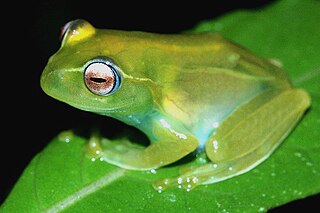
Mantidae is one of the largest families in the order of praying mantises, based on the type species Mantis religiosa; however, most genera are tropical or subtropical. Historically, this was the only family in the order, and many references still use the term "mantid" to refer to any mantis. Technically, however, "mantid" refers only to members of the family Mantidae, and not the 14 remaining families of mantises. Some of the most recent classifications have promoted a number of the mantid subfamilies to the rank of family, e.g. Iridopterygidae, Sibyllidae, Tarachodidae, Thespidae, and Toxoderidae, while other classifications have reduced the number of subfamilies without elevating to higher rank.
Articles related to Madagascar include:

Boophis is the only genus in the mantellid frog subfamily Boophinae. They are commonly known as bright-eyed or skeleton frogs. They show typical 'tree frog' traits, and are a good example of convergent evolution with morphologically similar species in the families Hylidae and Rhacophoridae, among others. This genus can only be found on Madagascar and Mayotte Island (Comoros).
Boophis mandraka is a species of frog in the family Mantellidae. It is endemic to Madagascar, officially known only from Mandraka Park with unconfirmed records in Andohahela National Park, Ambatovaky Reserve, Anjanaharibe-Sud Reserve and Andasibe-Mantadia National Park. Its natural habitats are subtropical or tropical moist montane forests, rivers, and heavily degraded former forest. It is threatened by habitat loss for agriculture, timber extraction, charcoal manufacturing, invasive eucalyptus, livestock grazing and expanding human settlement.
Mesopristes elongatus is a species of fish in the family Terapontidae known by the common name plain terapon. It is endemic to Madagascar, where it occurs in several rivers along the eastern coast. Its populations are thought to be decreasing due to habitat loss and degradation, which is accelerated by the siltation caused by deforestation.

Mantasoa is a municipality in Madagascar. It belongs to the district of Manjakandriana, which is a part of Analamanga Region. The population of the commune was 10,604 in 2018.
Gallienica is a genus of moths in the family Erebidae erected by Paul Griveaud in 1976. All the species are known from Madagascar.

Strabena is an Afrotropical butterfly genus endemic to Madagascar from the subfamily Satyrinae in the family Nymphalidae.
Strabena mandraka is a butterfly in the family Nymphalidae. It is found on Madagascar. The habitat consists of forests.

Manjakandriana District is a district in central Madagascar. It is part of Analamanga Region. Its capital is Manjakandriana.
Jirama is a state-owned electric utility and water services company in Madagascar.

Mantasoa Dam is a buttress dam on the Varahina-North River, a tributary of the Ikopa River, near Mantasoa in the Analamanga Region of Madagascar. The dam was constructed by French contractors between 1937 and 1938. It creates Lake Mantasoa which has a surface area of 20 km2 (7.7 sq mi). The dam itself is made of 8,000 m3 (10,000 cu yd) of concrete and has a reinforced buttress design. Water released from the dam supplies a regulated flow to hydroelectric power station at the Antelomita Dams downstream. A saddle dam on the north side of the Mantosoa reservoir regulates water flow into the Mandraka River for the Mandraka Dam downstream.

The Tsiazompaniry Dam is a buttress dam on the Varahina-South River, a tributary of the Ikopa River, near Tsiazompaniry in the Analamanga Region of Madagascar. The dam was constructed by a French firm in 1956. It creates Lake Tsiazompaniry, the largest reservoir in the country, which has a surface area of 31 km2 (12 sq mi) and a storage volume of 260,000,000 m3 (210,000 acre⋅ft). A second buttress dam, 1 km (0.62 mi) northwest of the main dam helps withhold the reservoir. Water released from the dam supplies a regulated flow to hydroelectric power station at the Antelomita Dam downstream. Efforts to install a 5.25 MW power station at the base of the dam began in 2011.

Mandraka Dam is a gravity dam on the Mandraka River near Mandraka in the Analamanga Region of Madagascar. The dam was constructed by a French firm by 1956 and creates Lake Mandraka.
The Antelomita Hydroelectric Power Station is located in the rural commune Anjeva Gara of the Analamanga Region, Madagascar. The hydroelectric power station comprises two parts, Antelomita I and II. Both are adjacent to one another on separate water falls along the Ikopa River. Each water fall is dammed and water is diverted to the power station; each of which contains three 1.4 megawatts (1,900 hp) generators. The first two were commissioned in 1930, the second two in 1952 and the final two in 1953. Both stages have an installed capacity of 8.4 megawatts (11,300 hp). They were built by a French firm but are now owned and operated by Jirama. The Tsiazompaniry and Mantasoa Dams upstream regulate water to the power station.

Madagascar Exotic is a small privately run reserve at Marozevo, on National Road N2, 75 km (47 mi) east of Antananarivo, between the towns of Manjakandriana and Moramanga. It is a popular tourist stop between Antananarivo and Madagascar's Andasibe-Mantadia National Park.
Dr André Peyriéras received his doctorate from the University of Montpellier in France. He settled in Madagascar in 1954 and lived there until 2005. He became one of Madagascar's most eminent entomologists, herpetologists and plant collectors.

Lake Mantasoa is a large lake with a surface area of 20 km2 (7.7 sq mi), created by the Mantasoa Dam on the Mantasoa River in the commune of Mantasoa, Analamanga region of Madagascar.

The Tenoderinae are a subfamily of praying mantids, originally used by Brunner von Wattenwyl. It was restored as part of a major revision of mantid taxonomy, and contains many genera previously placed in the subfamily Mantinae.








